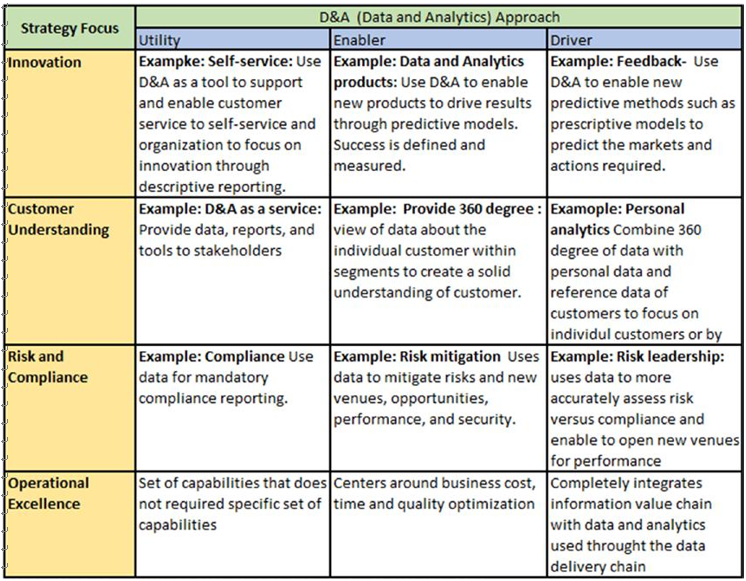
Mappings – Business Intelligence
Mappings
The purpose of this matrix is to align the focus of business strategy with data analytics strategy. Like all the programs, questions to be answered include, What is the value or value proposition for our customers in terms of providing data insights? What business process and response changes give these new insights?
Figure 7-11 shows an example of a matrix that maps the strategic focus of a business with a data and analytics approach.

Figure 7-11. Reference business to data strategic alignment
All organizations use multiple approaches and multiple business strategies.
There are four areas in an organization that are focused on simultaneously. It might be more focused on one area than others, depending on the industry or market forces or time of the year.
The approach varies based on the organization’s data and analytics capabilities. When maturity is low, data and analytics are used as a utility only. As maturity increases, data and analytics act as an enabler for achieving business goals, and in the case of
highest maturity, data and analytics drive the business goal. The four areas of focus are as follows:
1. Innovation: When self-service for analysts is missing. Providing data availability would be the most value addition across enterprise domains. This is the first step to achieve innovation across organization; for example, using data and analytics tool for business users for self-service and enabling the organization to focus on innovative products and services.
2. Customer Understanding: As a core strategy, a business must collect data internally, as it is core and central to all analyses. Even though a department may try to analyze data from different points of view and try to connect all data manually, there is a lack of a platform where analysts can have a 360-degree view
of data. Having one analytics platform will enable the business to have a better understanding of all domains quickly and with minimal effort. Second, an organization may already be creating new products. However, having an analytics platform will take a driver’s seat and actively partake in personal analytics.
3. Risk and Compliance: As per current assessment, organizations create compliance reporting. But these reports are used primarily for compliance. Having a data and analytics platform can be enabled for risk mitigation.
4. Operation Analytics: This data and analytics enablement centers around cost, time, and quality optimization. However, having
a data and analytics platform will not only enable operations analytics but evolve to completely integrate the information-value chain with data and analytics used thought the data-delivery chain of the organization. This generally centers around business cost, time, and quality optimization.
Data strategy is generally owned and maintained by a governance council with the guidance of a chief information officer or chief data officer and other management executives. These executives may retain ownership and control of data strategy. Data strategy has three major separate execution deliverables, as follows:
1. Data management program charter: Like any program charter, it consists of overall vision, goals, objectives, guiding principles, business case, measures of success, critical success factors, identified risks, and risk mitigation plans.
2. Data management scope statement: Scope of the programming consists of which projects or programs will bring exact business benefits within the planning horizon of usually three to five years and the roles, organization, and individual leaders accountable for achieving these objectives.
3. Data management benefit realization plan: Program work breakdown structure consists of the following:
• Combination of multiple and specific related projects making up the program
• High-level planning horizon in a range of three to five years
• Related major milestones of each project
• Deliverables, program plans and procedure, standards and processes, and public communications
Archives
- August 2024
- July 2024
- June 2024
- May 2024
- April 2024
- March 2024
- February 2024
- January 2024
- December 2023
- October 2023
- September 2023
- August 2023
- July 2023
- May 2023
- March 2023
- January 2023
- December 2022
- November 2022
- August 2022
- June 2022
- April 2022
- March 2022
- January 2022
- December 2021
- October 2021
- August 2021
- June 2021
- April 2021
- March 2021
- January 2021

Leave a Reply